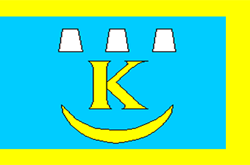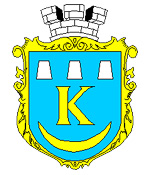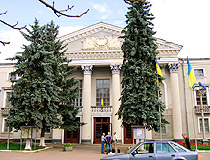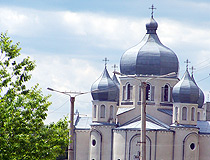History of Kalush
Foundation of Kalush
It is possible that a settlement on the site of today’s Kalush existed during the Principality of Galicia-Volhynia (1199-1253), one of the largest principalities during the collapse of Kievan Rus. However, it is not mentioned in the few surviving written sources of that time.
One of the first mentions of Kalush is found in the 12th volume of the Galician town books of the Galician eldership of the Crown of the Kingdom of Poland and is dated May 27, 1437. It was about “the trial on the coming Tuesday after Trinity with the participation of the crown man Dragush from Kalush against Mitka from Kurosh.”
To strengthen their positions in this region, the Polish authorities encouraged the creation of Roman Catholic parishes. In Kalush, this was marked by the construction of a Roman Catholic church in 1469. In 1478, a hospital and a school were opened at the church. Kalush was a rather important settlement, as salt was extracted here.
In 1549, the Polish king Sigismund II Augustus authorized the Belz voivode, crown hetman and Galician headman Nikolai Senyavsky to found the town of Kalush with the appropriate jurisdiction for self-government. Kalush became a “free town” with Magdeburg rights and its own coat of arms, which depicted three salt furnaces on a red background symbolizing its salt making industry.
More historical facts…
Kalush in the 16th-17th centuries
In the middle of the 16th century, Kalush turned into an administrative center with a castle, surrounded by ramparts. Kalush, like other towns of Galicia, was fortified to protect itself from the raids of nomads, mainly Crimean Tatars. In 1565-1566, there were ten salt springs in the town and several in the surrounding villages. In July 1594, as a result of the raid of the Crimean Tatars on Galicia, Kalush was burned down.
After the devastating raids of the Crimean Tatars in 1617, 1620, 1621 and a big fire, Kalush was completely rebuilt. A rectangular square was formed in the center, in the middle of which a wooden town hall was built, which was replaced by a stone one in the middle of the 17th century. The town hall was surrounded on all sides by shops where artisans sold their goods.
In the autumn of 1648, during the Khmelnytsky Uprising, also known as the Cossack-Polish War, Ukrainian self-government was established in Kalush, headed by Burgomaster Grits Volikovich. In December 1648, a number of Ukrainian officials in Kalush were executed by the Poles.
On October 16, 1672, near Kalush, the troops of Great Crown Hetman, the future Polish king, John III Sobieski, defeated a large detachment of the Crimean Tatars. A large number of people were released from captivity (among them more than 1,000 children). An orphanage was built for them in Kalush. In 1675, near Kalush, the Polish troops under the leadership of Field Crown Hetman Andrzej Potocki again defeated the Crimean Tatars.
Kalush in the 18th - early 20th centuries
In 1767, another big fire devastated Kalush. In 1770, a cholera epidemic cut the town’s population by almost half. In 1772, according to the first partition of Poland, Kalush, like the whole of Galicia with part of Volhynia, fell under the Austrian Habsburg rule. The Kalush castle was demolished. The architecture of the historical part of the town began to change.
The Austrian government introduced a state monopoly on salt. The Carpathian road was laid through Kalush, passing from Slovakia through the Yablunetskyi Pass and further through Kalush, Stanislavov (Ivano-Frankivsk), Kolomyia to Chernivtsi. In 1784, the German settlement (colony) of Novy (New) Kalush was founded near Kalush (577 people lived in it in 1881).
In 1804, during the deepening of a mine near Kalush, the so-called bitter salts were found - kainite and sylvinite. In 1867, a joint-stock company was established to develop local potash deposits. In 1869, a factory was built in Kalush that processed potash ores. In 1875, the Archduke Albrecht Railway was put into operation and the Kalush station was opened.
In 1909, a movie theater was opened in Kalush. Natural gas, discovered in 1910, was used to light the town, and from 1933 - for heating. In 1912-1913, an oil well was laid near Kalush, but instead of oil, deposits of combustible gas were discovered. In 1912, in order to facilitate the extraction of potash salts, the first power plant was built in Kalush. Subsequently, the electricity produced by it began to be used for the needs of the town.
In 1914, at the beginning of the First World War, Kalush was occupied by the troops of the Russian Empire. In 1915, they were forced to retreat. In 1918, after the collapse of the Austro-Hungarian Empire, the West Ukrainian People’s Republic was proclaimed, Kalush was part of it. In 1919, as a result of the Polish-Ukrainian War, Kalush, along with all of Galicia, was annexed to Poland.
Kalush during and after the Second World War
In 1939, about 13 thousand people lived in Kalush. On September 1, 1939, German troops attacked Poland, the German-Polish War of 1939 and the Second World War began. On September 17, 1939, the Red Army of the Soviet Union entered the eastern regions of Poland - Western Ukraine.
On September 28, 1939, the invasion ended with the signing of the Treaty of Friendship and Border between the USSR and Germany. On October 27, 1939, Soviet power was established in Kalush. On November 14, 1939, Kalush was incorporated into the Ukrainian Soviet Socialist Republic.
On July 2, 1941, 10 days after the German attack on the USSR, Kalush was occupied by German troops. During the German occupation, about 7 thousand Jews were shot in Kalush. A lot of residents of the town were taken to forced labor in Germany. On July 30, 1944, the Red Army regained control of the town.
In the 1960s, the Soviet authorities managed to change the industrial face of Kalush. New chemical plants, residential buildings, and social facilities were built.
In 1972, Kalush, the center of the Kalush district of Ivano-Frankivsk Oblast, had about 47 thousand residents. The city had chemical and metallurgical, food, and other plants; factories of reinforced concrete products and structures, utility equipment, mechanical repair, assembly and procurement, cheese-making, brewing; clothing and haberdashery factory; chemical-technological technical school.
In 1991, the population of Kalush was about 69 thousand people. Since December 8, 1991, Kalush has been a city within independent Ukraine.
Kalush streets
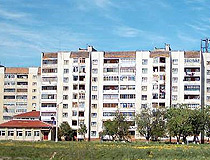
Apartment buildings in Kalush
Author: Vitaly Zloy
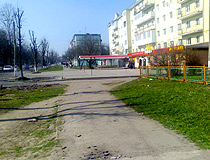
Kalush street view
Author: Andrew Karabetsky
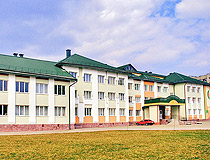
Summer in Kalush
Author: Oleg Bond
Kalush - Features
The name of Kalush probably comes from the Polish word “kaluza”, which literally means “puddle”. In the past, there were several natural salt springs on the territory of the present city, apparently this feature gave the name to the settlement founded here. The City Day of Kalush is celebrated on the 3rd Saturday of September.
Kalush is also the name of a Ukrainian rap group founded in 2019. Kalush Orchestra, a side project of the Kalush group, represented Ukraine at the Eurovision Song Contest 2022 with the song “Stefania” and won the competition. The group was named after Kalush, the homecity of Oleh Psiuk, the founder and lead singer of the group.
Today’s coat of arms of Kalush repeats the historical coat of arms adopted in the Austrian period of the history of the town. It depicts a golden letter “K” (the first letter in the city name), three silver salt furnaces, symbolizing salt production, the historical occupation of the locals, and a golden crescent, probably in memory of the Polish king John III Sobieski’s victory over a large detachment of the Crimean Tatars near Kalush in 1672.
The climate in Kalush is temperate continental, humid with cool summers and mild winters. The average temperature in January is in the range of minus 4-10 degrees Celsius, in July - plus 18-25 degrees Celsius. The climate of the city is significantly affected by the proximity of the Carpathian Mountains.
One of the main advantages of Kalush is its favorable geographical location and industrial potential. Within a radius of 200 km from the city there are borders with Poland (130 km), Slovakia (150 km), Hungary (160 km), Romania (130 km), which gives easy access to the countries of Central and Eastern Europe.
Kalush is an important industrial center of the western part of Ukraine. About one third of all industrial output of Ivano-Frankivsk Oblast is produced here. A number of unique types of products, such as potash mineral fertilizers, metallic magnesium, polyethylene, tufted coatings, are produced only in Kalush.
As a result of the development of potassium salt deposits and the activities of chemical enterprises in the Kalush district, the ecological balance in the rock mass of the Kalush-Golyn salt deposit was disturbed. This led to numerous sinkholes in the ground over the mines in Kalush, the destruction of houses and communications, and the salinization of water.
Main Attractions of Kalush
Ukrainian People’s House (1880) - a beautiful architectural monument that has become a symbol of Ukrainian culture of the late 19th century. This Art Nouveau building with elements of classicism was built to hold creative evenings and meetings of the cultural elite of the Ukrainian society of those years. In 1884, Ivan Franko, the famous Ukrainian writer, poet, and publicist, spoke here at a meeting of a literary club. Tarasa Shevchenka Street, 8.
Museum of the Family of Ivan Franko. Opened in 1992, this museum is housed in a small wooden building built by Omelyan, the younger son of Ivan Franko’s brother, in 1936. Here you can see old photographs, letters, household items, and much more. The four rooms of the museum tell about all the important milestones of Ivan Franko’s life. Ivano-Frankivska Street, 22.
Catholic Church of St. Valentine (1841-1845) - an elegant neo-Gothic architectural monument located in the central part of the city, one of the symbols of Kalush. This is the oldest stone building in the city that has survived to this day.
After the Second World War, it was used as a school gym. Later the building was given to the Ukrainian Orthodox Church. In 1999, the church was returned to the Roman Catholic parish and soon its renovation began. Tarasa Shevchenka Street, 10.
Church of the Holy Archangel Michael (1904-1913) - one of the main and oldest stone churches in Kalush, belonging to the Greek Catholic diocese. The church was built in the traditional Byzantine style and topped with five domes. Sheptytskoho Square, 9.
Church of St. Nicholas (1888) - a picturesque wooden church built in the Ukrainian Baroque style, one of the oldest wooden churches in Kalush. Yosypa Slipoho Street, 3.
Museum of History and Local Lore of Kalush. The exposition of this museum is located in the building of the former Jewish society, an architectural monument of the early 1930s. The exposition halls present the history of the region, ethnography, sacred art, and nature. The exposition includes archaeological monuments, old documents, books and photos, works of fine art, household items, etc. Tarasa Shevchenka Street, 9.


